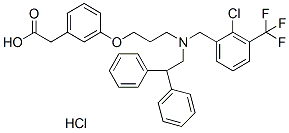All AbMole products are for research use only, cannot be used for human consumption.

GW3965 hydrochloride is an agonist for the liver X receptor (LXR), reduces angiotensin II-mediated pressor responses in Sprague-Dawley rats. GW3965 acts as a full agonist of hLXRα and hLXRβ (EC50 values are 190 and 30 nM respectively) in cell-based reporter gene assays. It is orally active in mice. When screened against a panel of nuclear receptors, it cross-reacted with only the pregnane X receptor (PXR). GW3965 hydrochloride displays potent antiatherogenic activity in mouse models of atherosclerosis. GW3965 dosing blunted the vasopressor effect of Ang II, which was significantly different with the 0.3 and 3 microg kg(-1) doses. GW3965 decreased Ang II-mediated vasopressor responses coincident with a trend toward reduced ATR gene expression, suggesting that LXR agonists could affect vascular reactivity. Alternate studies suggest that GW3965 hydrochloride increases apoA-I protein levels in the central nervous system independent of ABCA1. Since ABCA1 is a major regulator of cholesterol and phospholipid metabolism, GW3965 hydrochloride is a useful tool to study these cellular functions.

Adv Sci (Weinh). 2023 Mar 27;e2207224.
Hypoxia Drives Material‐Induced Heterotopic Bone Formation by Enhancing Osteoclastogenesis via M2/Lipid‐Loaded Macrophage Axis
GW3965 hydrochloride purchased from AbMole

Cell Death Dis. 2019 Jun 5;10(6):439.
Loss of transglutaminase 2 sensitizes for diet-induced obesity-related inflammation and insulin resistance due to enhanced macrophage c-Src signaling.
GW3965 hydrochloride purchased from AbMole
| Cell Experiment | |
|---|---|
| Cell lines | RAW264.7 cells |
| Preparation method | Cellular Internalization of LXR Agonist RAW264.7 cells were seeded into 24-well plates at a density of 1 × 105 cells per well 24 hours prior to the experiment. NPs encapsulating a GW3965 concentration of 1 μM were then incubated with cells for the desired time points. Afterwards, the cells were washed with PBS, followed by trypsinization and centrifugation to remove excess trypsin-EDTA. Cells were then resuspended in PBS, and cellular uptake of NPs was assessed via flow cytometry (BD LSR II, BD Bioscience, San Jose, CA). Data were analyzed using BD FACSDiva software. |
| Concentrations | 1 μM |
| Incubation time | 2 h |
| Animal Experiment | |
|---|---|
| Animal models | atherosclerotic lesions in Ldlr−/− mice |
| Formulation | saline |
| Dosages | 10mg/kg |
| Administration | i.p. |
| Molecular Weight | 618.51 |
| Formula | C33H31NO3ClF3.HCl |
| CAS Number | 405911-17-3 |
| Solubility (25°C) | DMSO ≥90 mg/mL |
| Storage |
Powder -20°C 3 years ; 4°C 2 years In solvent -80°C 6 months ; -20°C 1 month |
| Related Liver X Receptor Products |
|---|
| Rovazolac
Rovazolac is a liver x receptor (LXR) modulator, which can be used in the study of immune system disorders and atopic dermatitis. |
| GW6340
GW6340 is an intestinal-specific LXR agonist. |
| Larsucosterol
Larsucosterol is an endogenous sulfated oxysterol and a potent hepatic X receptor (LXR) and DNA methylase (DNMTS) antagonist that regulates endogenous lipogenesis as well as inhibits cholesterol biosynthesis by lowering mRNA levels and inhibiting SREBP-1 activation. May be used in studies related to psoriasis. |
| 24(S)-Hydroxycholesterol
24(S)-Hydroxycholesterol (24S-OHC), the major brain cholesterol metabolite, plays an important role to maintain homeostasis of cholesterol in the brain. 24(S)-Hydroxycholesterol (24S-OHC) is one of the most efficient endogenous LXR agonist known and is present in the brain and in the circulation at relatively high levels. 24(S)-Hydroxycholesterol (24S-OHC) is a very potent, direct, and selective positive allosteric modulator of NMDARs with a mechanism that does not overlapthat of other allosteric modulators. |
| GW3965
GW3965 is a potent, selective liver X receptor (LXR) agonist with EC50s of 190 nM and 30 nM for hLXRα and hLXRβ, respectively. |
All AbMole products are for research use only, cannot be used for human consumption or veterinary use. We do not provide products or services to individuals. Please comply with the intended use and do not use AbMole products for any other purpose.


Products are for research use only. Not for human use. We do not sell to patients.
© Copyright 2010-2024 AbMole BioScience. All Rights Reserved.
